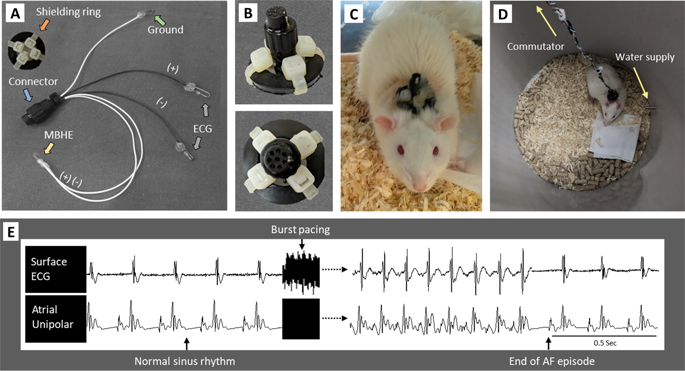Our official English website, www.x-mol.net, welcomes your feedback! (Note: you will need to create a separate account there.)
An implantable system for long-term assessment of atrial fibrillation substrate in unanesthetized rats exposed to underlying pathological conditions.
Scientific Reports ( IF 4.6 ) Pub Date : 2020-01-17 , DOI: 10.1038/s41598-020-57528-3 Hadar Klapper-Goldstein 1, 2 , Michael Murninkas 1, 2 , Roni Gillis 1, 2 , Wesam Mulla 1, 2 , Eran Levanon 1, 2 , Sigal Elyagon 1, 2 , Ronen Schuster 3 , Dor Danan 4 , Hagit Cohen 4 , Yoram Etzion 1, 2
Scientific Reports ( IF 4.6 ) Pub Date : 2020-01-17 , DOI: 10.1038/s41598-020-57528-3 Hadar Klapper-Goldstein 1, 2 , Michael Murninkas 1, 2 , Roni Gillis 1, 2 , Wesam Mulla 1, 2 , Eran Levanon 1, 2 , Sigal Elyagon 1, 2 , Ronen Schuster 3 , Dor Danan 4 , Hagit Cohen 4 , Yoram Etzion 1, 2
Affiliation

|
Atrial fibrillation (AF) is a progressive arrhythmia with underlying mechanisms that are not fully elucidated, partially due to lack of reliable and affordable animal models. Here, we introduce a system for long-term assessment of AF susceptibility (substrate) in ambulatory rats implanted with miniature electrodes on the atrium. Rats were subjected to excessive aldosterone (Aldo) or solvent only (Sham). An additional group was exposed to myocardial infarction (MI). AF substrate was tested two- and four-weeks post implantation and was also compared with implanted rats early post-implantation (Base). Aldo and MI increased the AF substrate and atrial fibrosis. In the MI group only, AF duration was correlated with the level of atrial fibrosis and was inversely correlated with systolic function. Unexpectedly, Shams also developed progressive AF substrate relative to Base individuals. Further studies indicated that serum inflammatory markers (IL-6, TNF-alpha) were not elevated in the shams. In addition, we excluded anxiety\depression due to social-isolation as an AF promoting factor. Finally, enhanced biocompatibility of the atrial electrode did not inhibit the gradual development of AF substrate over a testing period of up to 8 weeks. Overall, we successfully validated the first system for long-term AF substrate testing in ambulatory rats.
中文翻译:

一种可植入系统,用于长期暴露于潜在病理状况的未麻醉大鼠的心房纤颤基质评估。
心房颤动(AF)是一种进行性心律失常,其潜在机制尚未完全阐明,部分原因是缺乏可靠且负担得起的动物模型。在这里,我们介绍了一种对在心房中植入微型电极的非卧床大鼠进行AF敏感性(底物)长期评估的系统。大鼠接受过量的醛固酮(Aldo)或仅接受溶剂(Sham)。另外一组暴露于心肌梗塞(MI)。在植入后两周和四周对AF基质进行了测试,并与植入后早期的大鼠(基础)进行了比较。Aldo和MI增加了AF底物和心房纤维化。仅在心梗组,房颤持续时间与心房纤维化程度相关,而与收缩功能成反比。不料,相对于基础个体,Shams还发展了进行性AF底物。进一步的研究表明,血清炎症标志物(IL-6,TNF-α)在毛囊中并未升高。此外,我们排除了由于社交孤立而导致的焦虑/抑郁是促进房颤的因素。最后,在长达8周的测试时间内,增强的心房电极生物相容性不会抑制AF基质的逐渐发展。总体而言,我们成功验证了第一个用于非卧床大鼠长期AF底物测试的系统。在长达8周的测试时间内,增强的心房电极生物相容性不会抑制AF基质的逐渐发展。总体而言,我们成功验证了第一个用于非卧床大鼠长期AF底物测试的系统。在长达8周的测试时间内,增强的心房电极生物相容性不会抑制AF基质的逐渐发展。总体而言,我们成功验证了第一个用于非卧床大鼠长期AF底物测试的系统。
更新日期:2020-01-17
中文翻译:

一种可植入系统,用于长期暴露于潜在病理状况的未麻醉大鼠的心房纤颤基质评估。
心房颤动(AF)是一种进行性心律失常,其潜在机制尚未完全阐明,部分原因是缺乏可靠且负担得起的动物模型。在这里,我们介绍了一种对在心房中植入微型电极的非卧床大鼠进行AF敏感性(底物)长期评估的系统。大鼠接受过量的醛固酮(Aldo)或仅接受溶剂(Sham)。另外一组暴露于心肌梗塞(MI)。在植入后两周和四周对AF基质进行了测试,并与植入后早期的大鼠(基础)进行了比较。Aldo和MI增加了AF底物和心房纤维化。仅在心梗组,房颤持续时间与心房纤维化程度相关,而与收缩功能成反比。不料,相对于基础个体,Shams还发展了进行性AF底物。进一步的研究表明,血清炎症标志物(IL-6,TNF-α)在毛囊中并未升高。此外,我们排除了由于社交孤立而导致的焦虑/抑郁是促进房颤的因素。最后,在长达8周的测试时间内,增强的心房电极生物相容性不会抑制AF基质的逐渐发展。总体而言,我们成功验证了第一个用于非卧床大鼠长期AF底物测试的系统。在长达8周的测试时间内,增强的心房电极生物相容性不会抑制AF基质的逐渐发展。总体而言,我们成功验证了第一个用于非卧床大鼠长期AF底物测试的系统。在长达8周的测试时间内,增强的心房电极生物相容性不会抑制AF基质的逐渐发展。总体而言,我们成功验证了第一个用于非卧床大鼠长期AF底物测试的系统。


























 京公网安备 11010802027423号
京公网安备 11010802027423号